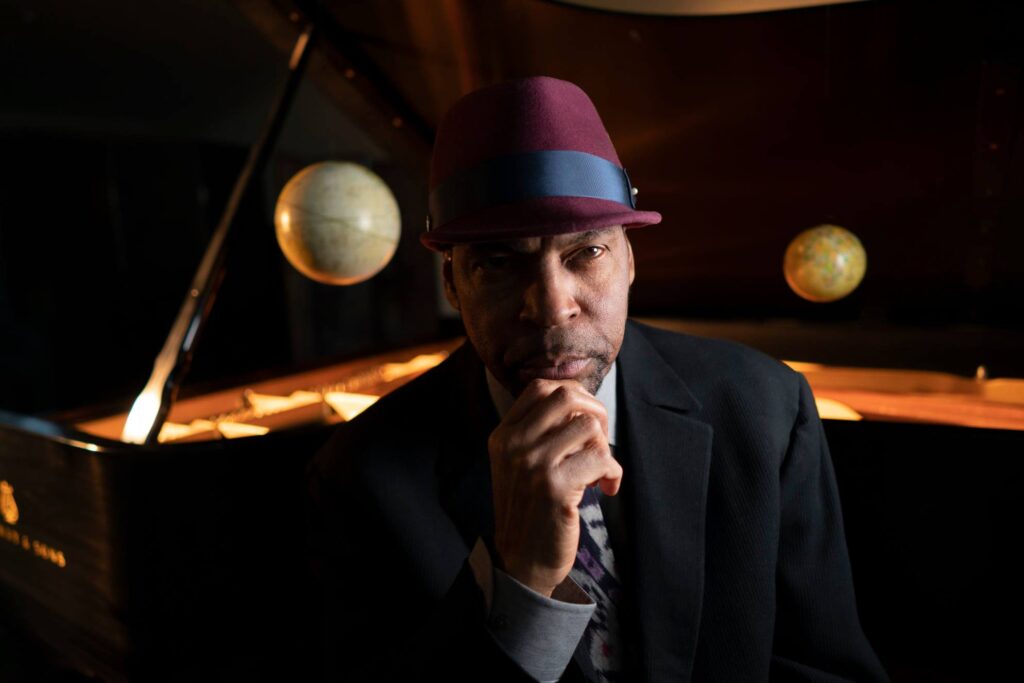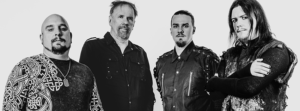Todd Cochran – Notes For The Jazz Future!

1. Congratulations on the release of “Notes for the Future” from the vault! Can you tell us more about this project and the inspiration behind it?
From The Vault: Notes For The Future is the first electronic album I’ve released in my career, and it expresses an elemental slice of the music shaping my worldview. This project reconnects me with an area of music-making that began early in my career when the possibilities with synthesizers and electronic keyboards excited my curiosity. Incorporating electronics into my sound palette put me on a path of discovery and adventurous music-making across a range of genres.
When working from a philosophy of openness, your creative choices follow your state of mind. And I’ve seen that whenever we can pare our lives down to thinking about just now – taking in the moment we’re in – we get a clear glimpse of what we need to do next. The inspiration leading to this album’s formation came together over time as I observed the similarities in the persistent human issues around the globe. As I became more conscious of the real peril we as a world society face in a prevailing climate of disconnect, fear, and division, I was driven to write something about it. Specifically to bring light to the same problems we see over and over again. These ten compositions reflect different moods, modalities, and textures that crisscross cultures in instrumentation, style, and cadence. My intention was to see how I could mold a combination of musical languages into a snapshot of our contemporary world in an unprecedented time of transition. Where I landed was telling an allegorical story in a setting of futurism.
2. How has your experience with the band Automatic Man influenced your musical journey and the creation of this album?
Automatic Man will always be part of my DNA. What we achieved as a band came from a meeting of the minds. Rooted in trust, we worked in a cohesive, cooperative way, and our sound emerged. We set a collaboration model by following our instinctive sensibilities that I’ve carried forward into all of my involvements since. At the core of the band was a credo of creative freedom and an openness to trying all the ideas that came up in our practices and rehearsals. Whose idea it was didn’t matter – we gave it a listen. The result was an energy of comradery that allowed us to be our best musical selves.
The background-foreground relationships in the compositions on this recording characterize a shift in my approach to writing and interweaving narratives with music. While developing the narrative and music of From The Vault: Notes For The Future, I was involved in an inner dialog that switched between fiction and reality, remembering and imagining. Alternating perspectives created an experimental tone and an unstructured free space for the unknown to enter. With Automatic Man, the concept oscillated between the Antediluvian (the world before the flood) and a prescient psychic future. Verbalizing the theme were the words, syllables, and rhyming phrases that the music enlarged. In contrast, with From The Vault – as there are no words, either sung or spoken – I worked in the sequence of “story to picture to sound to music.” So, with the syntax embedded in the music, I hope pictures and images will emerge from the sounds while listening.
3. “Notes for the Future” features previously unreleased material. What led you to revisit these tracks and release them now? How do they fit into the broader narrative of your musical career?
In a word, synchronicity has everything to do with how this album came together. Significant elements of the music were in various stages of completion, written in sketchbooks, with other segments that I’d recorded and orchestrated stored in my audio library. I clearly remember my mental conversations about broadening my sonic language. Musing about it reconnected me to past adventures in electronic music, sound concepts, and synthesizers – something I’d stepped away from for some time. I’d spent most of the year working on commissions for acoustic instruments and extended techniques. One standout project, a postmodern piece for winds, percussion, and electronic keyboards, was particularly inspiring. In the same timeframe, I collaborated with a close friend and an extraordinary lineup of musicians on an electric blues recording. The keyboards I played during the sessions utilized the latest technology for manipulating granular samples of the original classic instruments. The realism that’s possible is remarkable. These projects were momentous to the extent that I began researching new electronic tools and seeing what could be added to my palette – unexpectantly reactivating an area of my music-making that had lied dormant for a while. Then came a nudge from an unexpected muse who thought it was an excellent time for me to revisit some of the tucked-away electronic tracks in my library – to remove the little patina holding it back and put it out there. Without question, happenstance set the scene for the album and concept to take form.
This music works with my curiosity about the world that my parents first sparked. Growing up, my mind was saturated with two musical worlds, classical and jazz. I love them both, and they’ve always overlapped. My interests broadened and now span multiple genres. I approach each with humility, as art reminds you that there is always much more to know. Progressive and experimental, mine is trans-idiomatic music. I have endless deference for all things cultural.
Tying the concept of From The Vault: Notes For The Future to the narrative in all my music is a central theme of time and our understanding of it. Do we inhabit time, or are we contained in it? Is it time to do this? Is it time to stop doing that? By rote, I’m an accidental activist, resulting from the worldview I gained by osmosis. From the capable adults I was surrounded by, I saw the importance of doing whatever your part may be to affect positive progress wherever it’s needed – and that it’s powerful that we can talk to each other across cultures. I stand in the tradition of creating music that stimulates us and grows awareness of fixable issues that will improve the world if addressed. All humans have a yearning for connection, love, and not to exist in fear.
4. Can you share some insights into the creative process behind the album? How did you approach selecting and arranging the songs, and did you make any updates or changes to the original recordings?
Composing for me is a practice, and I work at it every day. Most of the music I write is only heard by myself. While bringing this music together, my approach was dream-catching the ideas that were downloading into my mind at the beginning of each day rather than fixing my attention to something specific. The musical mind doesn’t do a great job of retrieving thoughts and works best in the present. There’s only the immediate moment you are in; connecting those moments forms the story.
This music migrated from one phase of completion to the next. A composition is not finished until you feel confident you’ve taken it as far as possible, and once a piece is complete, it’s on to how the tracks fit together best. My initial phase was to define and set the parameters of the sonic palette and choose the instruments and sounds to be used – to unify the colors and shape the holistic character of the music. From there, I focused on contouring the melodies, textures, rhythms, and tempos – updating the elements until they worked together. I aim for the listener to travel with the music as their ears are continually refreshed.
5. Notes for the Future” combines elements of jazz, fusion, and funk. How would you describe the overall sound and style of the album? What can listeners expect from it?
At heart, I’m a bluesman, and the jazz aesthetic has been vital to me finding my voice and connection to a relatable lived experience. Originating with the blues, specific rhythms, chords, and cadences have become indelible tropes of musical expression. So, when we look at fusion, funk, and innovations that blur the boundaries of genre, we recognize them as tributaries of the bluesman’s dream.
I would describe the sound and style of this album as “magical realism.” The images of futurism emerge out of the storyteller’s quest for expanding consciousness. Listeners can connect with the music in a literal sense, as a stylized form of something they may already be somewhat familiar with. Alternatively, they can experience it heart-to-heart as personal facts that ask them on a deeper level to look at challenging issues that define our era. I hope that the music can be something of a dream space that people can see themselves inside that transports their imagination from one place to another.
6. Were there any particular challenges or highlights while working on this project? How did you navigate the process of revisiting older material and bringing it to the present?
In the studio, there were times when I had to step away from the music table and let things marinate for a while, go into nature, and return with another strategy. While in the production mode, I envisioned this music in two contexts. Beyond what was happening in the studio environment, I balanced the recording phase with how the music will be performed live. The velocity of the music changes with a live audience in the equation. You stretch specific passages and make the sequencing more deliberate and dramatic as you invite the audience to join the music with you.
Revisiting older material grounds you in your musicianship and musicality. It’s a mode of reorientation to the reasoning philosophy that inspired the musical map. Navigating back to where I was when I originally wrote the piece, I enter a mindset of experiencing the music as though I was hearing it for the first time. The surprise and spontaneity bring aliveness and daring to what you’re playing. The experimental impulse comes in clusters of ideas, with your playing becoming entirely instinctual. You decipher the original and poetic core of the piece – and separate it from the afterthoughts.
7. Is there a specific song or moment on the album that holds special meaning to you? Could you share the story behind it and why it stands out in your musical journey?
A moment of special meaning was when I recognized that the appeal of returning to electronic music was calling me. It wasn’t me cultivating something I knew little about but revitalizing a part of my musical track that I’d not utilized in a while. All these thoughts were looping and very clear while composing and recording “Inseparable” – the last track on the album. The story in “Inseparable” teems with images of another kind and is about joining. While being exposed to and stretched by new ideas and new faces, new ways, and concerns about survival, we’re programmed to hold on to old models of community, only to discover that in a truly advanced society, “community” is not about sameness. The storyteller describes how authentic community allows us to interact with people we may not otherwise encounter. There is a sense of belonging – everyone is respected, welcomed, and honored for the differences they bring. This innovative “community” is where connection, true inspiration, and purpose live. With an illuminating gesture, the storyteller reveals how with compassion, we get a glimpse of the sacred structure. And in that instant, we see that “Om” and “Amen” are the same thing.
The blending of musical languages stimulates memories for me. In my late teens, I began playing with, was mentored by, and composed for Charlie Mingus alumni, saxophonist John Handy. As a result, early on, I saw art as a diverse stream. Observing John’s collaborations with Indian classical musicians Ali Akbar Khan and Zakir Hussain as paralleling Mahatma Gandhi’s influence on the Martin Luther King-led civil rights movement left a deep impression on my outlook. Representing the traditions of India in this context is especially meaningful to me.
8. With the release of “Notes for the Future,” how do you feel your music has evolved or progressed since your time with Automatic Man? Are there any new elements or influences that you’ve incorporated into this album?
Since Automatic Man, my understanding of music has grown with the experiences I’ve gained from the collaborations and musical camps I’ve been in. After a powerful debut, the band’s dissolution was an inflection point for me, and for a while, I felt exiled from my musical purpose. Nevertheless, while widening my grasp of prog-rock and electronic keyboards, I also put energy into developing other areas of my musical interests. This put me on a path where people from different music disciplines and takes on pop culture invited me to collaborate with them. It’s been music first, relationships multicultural and multiracial, and interacting with artists in the intimate processes of creating music. Making music from real life and communicating to an audience truly enriches my understanding of the human spirit.
With Automatic Man, what ignited us from the beginning was a blend of urgency and focus. I’ve carried that awareness and energy forward and realize that, in every instance, the best musical choices come from being inspired.
Inspiration guided every part of the journey of making From The Vault: Notes For The Future. The music is a mélange of musical influences from the traditions of the African and Asian diaspora, global pop, jazz, and contemporary art music. In a word, it’s music. The newest element in this recording is the sound language I’ve absorbed from working in Southeast Asia – writing new pieces, performing in Singapore, and incorporating my collection of Balinese Gamelan percussion from trips to Indonesia.
9. How do you think this release will resonate with longtime fans of your music, as well as new listeners who may be discovering your work for the first time?
I deeply value my longtime listeners and believe they will hear the insistent message of the subjects and concerns I shape my ideas around. I work from a “no repeat” philosophy and am skeptical of artists who are comfortable – people who feel certain and comfortable all the time. A relationship where there’s the expectation of continuous growth is healthy. I treasure the relationship I have with listeners and learn from their feedback!
To new listeners, beyond measure, I, with my music, am reaching out with the hope that together we can create little islands of peace and a place we can escape to and discover a space of unity and optimism that we bring back to our everyday life, relationships, and actions.
10. What are your plans for promoting “Notes for the Future” and connecting with your audience in the coming months? Will there be any live performances or other exciting events related to the album?
About 8 years ago, while shooting a mini-doc for the CD re-release of my album “Worlds Around The Sun,” the impact of visuals connecting an audience to music on a deeper level seized my attention. Storyboarding, scripting, and producing short films have been a part of my creative agenda since. In the pipeline to be released in new media are videos exploring the album’s backstory and experimental vignettes that expand the allegory futurism narrative of the music. Additionally, I’m doing interviews with journalists, authors, and a host of music-focused podcasts. The intersectionality and bridges between music, visual art, and dance are limitless. Still, it all comes together in live performance, where the energy exchange that can only occur when interacting with a living, breathing audience brings home everything I know the music experience to be. I’m looking forward to and am thrilled about performing this album’s music in concert in a wide range of venues.
Information: https://toddcochran.com/


